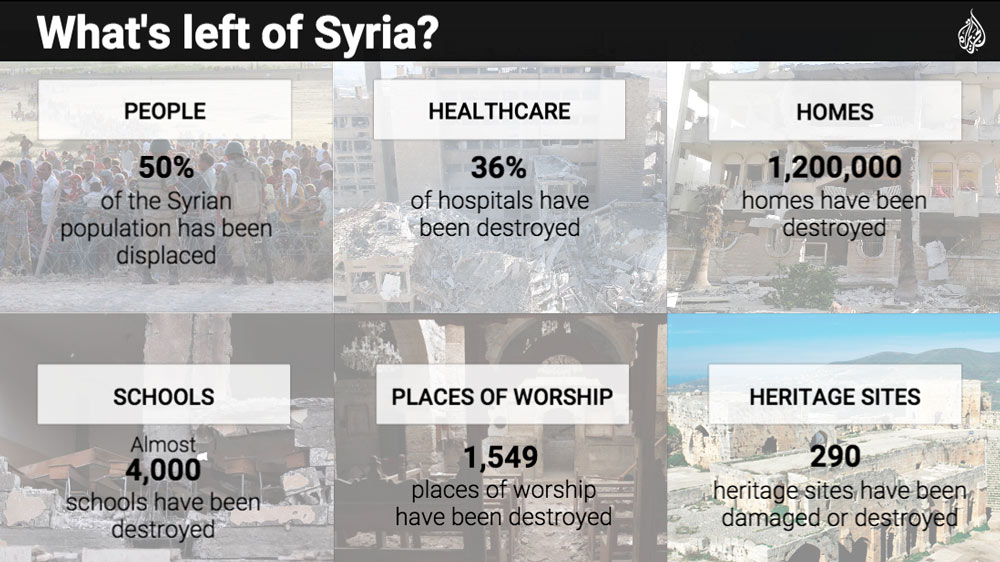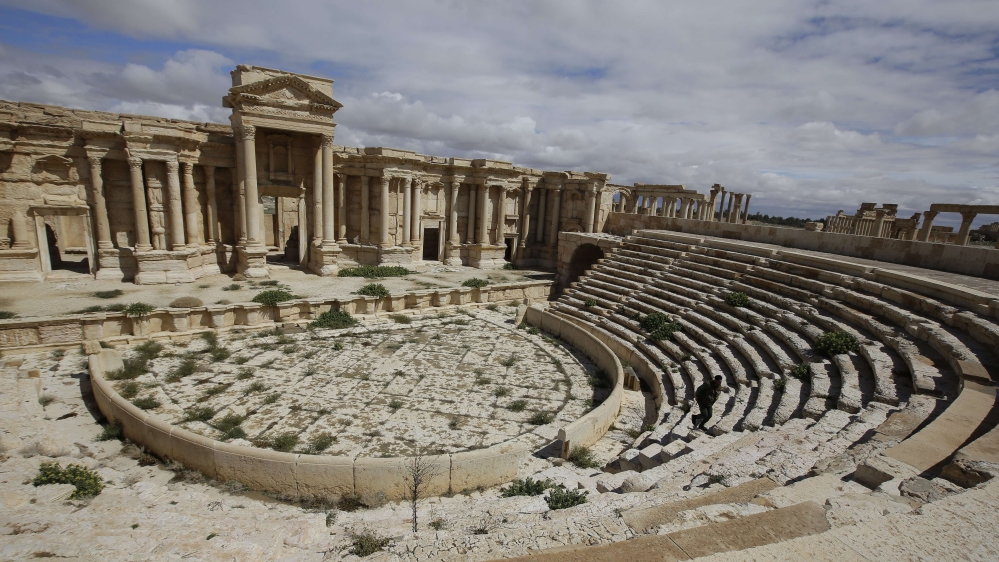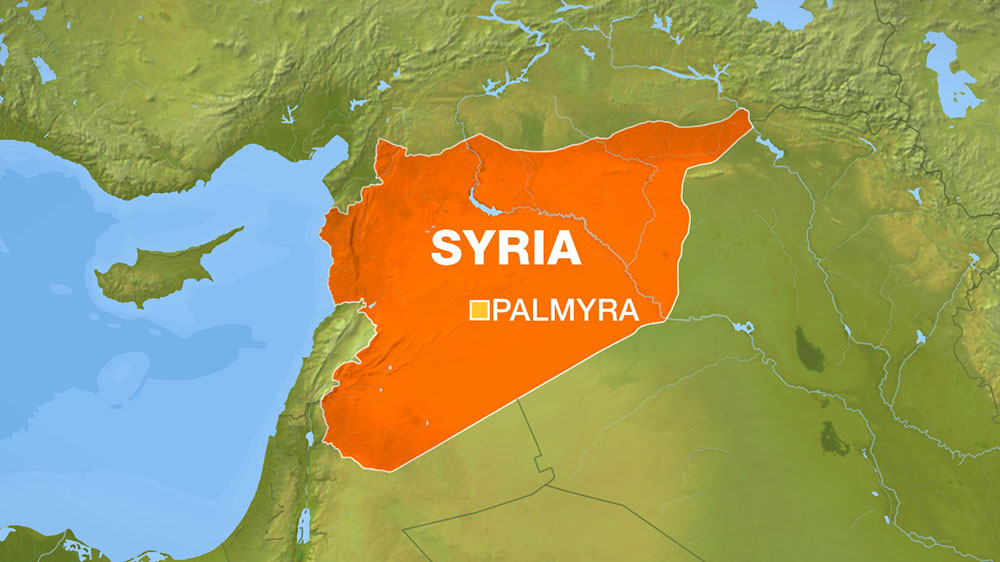U.S. Special Forces Kill Senior ISIS Leader in Syria, Capture His Wife
Officials say Abu Sayyaf helped direct group’s oil, gas and financial arms, was emerging as a leader of military operations
 ENLARGE
ENLARGE
U.S. Defense Secretary Ash Carter, shown here on May 1, on Saturday said a special forces raid that killed a senior Islamic State leader Abu Sayyaf and captured his wife was a significant blow to the militant group. PHOTO: MANUEL BALCE CENETA/ASSOCIATED PRESS
By
GORDON LUBOLD
Updated May 16, 2015 4:19 p.m. ET
345 COMMENTS
WASHINGTON—A senior Islamic State leader was killed, and his wife captured, in a raid in eastern Syria by U.S. Special Operations forces, the first on-the-ground mission in that country targeting wanted extremists, defense officials said on Saturday
The operation was conducted at Al-Amr, in the eastern region of Syria, to capture Abu Sayyaf and his wife, Umm Sayyaf, also thought to be part of the organization, Pentagon officials said.
During the mission late Friday, Abu Sayyaf “engaged U.S. forces” and was killed. Special Operations forces, however, captured Umm Sayyaf, the Pentagon said.
RELATED READING
The mission was a rare example of U.S. forces conducting an operational maneuver on the ground. Last year, Special Operations forces conducted a risky but ultimately unsuccessful attempt to rescue American journalists James Foley and Steven Sotloff and other hostages in eastern Syria.
“The operation represents another significant blow to ISIL, and it is a reminder that the United States will never waver in denying safe haven to terrorists who threaten our citizens, and those of our friends and allies,” according to a statement issued by Defense Secretary Ash Carter.
Islamic State is sometimes referred to as ISIS or ISIL.
The raid marked a bright spot for the U.S. effort in Iraq and Syria, after Islamic State forces have logged gains in recent weeks in both countries, including an offensive in the Iraqi city of Ramadi.
Members of U.S. congressional intelligence committees were notified of the impending raid during the week. “I am pleased Congress was notified,” said Rep. Devin Nunes (R., Calif.). “We have to do more of these operations.”
Abu Sayyaf was said to have helped direct the terrorist organization’s illicit oil gas and some financial operations that help fund Islamic State’s operations. He was also emerging as a leader of the group’s military operations.
Abu Sayyaf means “bearer of the sword” in Arabic and is also the name of a militant group in the Philippines.
One senior defense official described him as the CFO, or chief financial officer, of Islamic State, making the raid “an important factor in the long-term destruction of ISIL.”
The official indicated U.S. forces may have gained potentially valuable intelligence in the operation. “We now have reams of data on how ISIL operates, how they communicate and how they earn and manage finances,” he said. “In the oil and gas sector, we believe that we have temporarily dismantled their earning capacity with a single raid.”
A midlevel Islamic State commander said Abu Sayyaf was responsible for the group’s finances, known internally as “bayt al-mal,” an Arabic term that translates into “the house of money.”
The commander said the American commandos may have tracked down Abu Sayyaf after being tipped off by a member of Islamic State. “There must be betrayal,” he said. “We’re going to fix it.”
Islamic State leaders tend to change locations frequently and the identities of its most senior leaders, like Abu Sayyaf, are purposefully left unclear—even internally. Many of its rank-and-file fighters are unaware of who comprises the inner circle of leader Abu Bakr al Baghdadi.
After her capture, Umm Sayyaf was being held by U.S. officials in Iraq. She is thought to have been keeping a young Yazidi woman as a slave. The Yazidi woman was freed and will be reunited with her family in coming days, according to U.S. officials.
‘The operation represents another significant blow to ISIL.’
—U.S. Defense Secretary Ash Carter, in discussing Friday’s raid.
“We suspect that Umm Sayyaf is a member of ISIL, played an important role in ISIL’s terrorist activities and may have been complicit in the enslavement of the young woman rescued last night,” according to National Security Council spokespersonBernadette Meehan.
Ms. Meehan said the U.S. was debriefing Umm Sayyaf to obtain intelligence about Islamic State operations as well as to “determine any information she may have regarding hostages—including American citizens who were held by ISIL.”
According to Syrian antiregime activists from Islamic State stronghold of Deir Ezzour province, where the U.S. operation took place, the raid occurred in the housing units of the al-Omar oil field. The name they used for the area of the U.S. raid is slightly different than that given by American military officials, Al-Amr.
When Islamic State raided northern Iraq last summer in an offensive against the Yazidis, a religious minority they deem heretics, they killed Yazidi men and enslaved women and children who were unable to escape.
The militants then distributed Yazidi slaves to senior leaders, and al-Omar, the site of the U.S. raid on Friday, was the entry point for Yazidis destined to serve Islamic State in Syria.
The White House has been reluctant to send U.S. forces into harm’s way in Syria and in Iraq, maintaining the pledge President Barack Obama have no “combat boots” on the ground in either country.
Mr. Obama authorized Friday’s raid with what the White House described as the unanimous recommendation of his national security team as well as the consent of Iraqi authorities.
A senior U.S. official cited Abu Sayyaf’s likely close connection to Islamic State leader Abu Bakr al-Baghdadi as the probable reason why the administration would mount the risk of inserting ground troops into Syria to capture Abu Sayyaf.
The mission was begun after U.S. military officials had developed enough intelligence, using drones and other methods, to be sufficiently confident that the mission could succeed, likely taking extra precautions after the failed rescue attempt for Messrs. Foley and Sotloff last year.
In Friday’s raid, members of the Army’s Delta Force flew from Iraq into eastern Syria in UH-60 Black Hawks and V-22 Ospreys and landed near a multistory residential compound in a rural area of eastern Syria, in which Abu Sayyaf was known to be staying, the senior defense official said.
 ENLARGE
ENLARGE
Iraqis from Ramadi flee the Islamic State militants’ taking of the center of their city in western Iraq. People, such as those pictured above, spent the night walking toward Baghdad, 60 miles away. PHOTO: HADI MIZBAN/ASSOCIATED PRESS
The Delta Force team members jumped out of their helicopters, blew a hole in the side of the building and entered it to apprehend Abu Sayyaf and his wife, according to the senior defense official.
But in the scramble that ensued, Abu Sayyaf engaged the Americans, using women and children as human shields, according to the defense official. Eventually, the American force was able to separate the fighters from the civilians, ultimately killing 12 Islamic State fighters, including Abu Sayyaf.
“We intended to snatch him, but he did something threatening enough that we had to kill him,” the official said.
The operation was more dramatic than military planners might have expected, the official said. “It turned out to be a real fight,” the official said, noting that at least one Black Hawk had bullet holes in it as it pulled away. “There was actually hand-to-hand combat.”
It was unclear how long American forces were on the ground, but the overall mission took several hours from the time the helicopters lifted off a helipad in Iraq until returning there, the official said.
Syrian television reports indicated that Syrian forces had assisted in the operation, actually killing Abu Sayyaf and that dozens of Islamic State fighters were also killed. But the U.S. defense official said no Syrian forces were involved in the operation and no such forces “helped or opposed us.”
The official said the U.S. had been tracking Abu Sayyaf for some time and some officials believed the operation was expected to have taken place as long as a month ago, a sign of the caution the U.S. military exercised in tracking his whereabouts and mounting the operation late Friday.
Abu Sayyaf is Tunisian, a senior Obama administration official said. The U.S. government informed the Tunisian government about the operation after the fact, but before the raid was made public, the official said.
The deployment of ground troops in Syria, albeit briefly, indicates Abu Sayyaf and his wife represented valuable targets, potentially rich for the intelligence that could be gleaned from them or because they may have played a specific role in a significant operation, said Juan Zarate, a former counterterrorism official at the White House.
“This is more significant than Abu Sayyaf,” Mr. Zarate, now a senior adviser at the Center for Strategic and International Studies, a think tank in Washington, in an interview Saturday. Mr. Zarate said he believes U.S. military and intelligence agencies are “growing better at understanding who [Islamic State’s] leaders and where they are,” and the U.S. is more willing to go after them in Syria. “That suggests a shift in our willingness to assume a certain degree of risk and our willingness to go after them where they are hiding.”
 ENLARGE
ENLARGE
Members of U.S. congressional intelligence committees were advised of the Friday's operation earlier last week. Rep. Devin Nunes, R-Calif., pictured above in 2013, said on Saturday that he was pleased with the administration’s advance notice of the raid and that more of those operations are needed. PHOTO: ASSOCIATED PRESS
There have been reports for weeks that Abu Bakr al-Baghdadi, the known leader of Islamic State, was wounded in a battle, but those reports haven’t been confirmed, and U.S. officials still aren’t sure about his status.
An audio recording that is apparently from Mr. al-Baghdadi was released this week by Islamic State that would be the first word from the leader, but U.S. defense officials said they couldn’t yet confirm its veracity.
“We have not been able to confirm that the audio recording released yesterday was authentic,” said Marine Brig. Gen. Thomas Weidley in a Pentagon briefing on Friday, noting that the message appealed for more fighters for Islamic State. “He asked for additional recruits, which shows that they are potentially stressed in terms of manpower to continue the fight.”
Another senior U.S. official said the operation in Syria demonstrates the administration’s resolve to the fight against Islamic State. “This shows our commitment to going after both their military and economic efforts,” the official said in an email.
—Adam Entous, Julian E. Barnes, Carol E. Lee, Nour Malas, Maria Abi-Habib, Felicia Schwartz and Dion Nissenbaum contributed to this article.
Officials say Abu Sayyaf helped direct group’s oil, gas and financial arms, was emerging as a leader of military operations

U.S. Defense Secretary Ash Carter, shown here on May 1, on Saturday said a special forces raid that killed a senior Islamic State leader Abu Sayyaf and captured his wife was a significant blow to the militant group. PHOTO: MANUEL BALCE CENETA/ASSOCIATED PRESS
By
GORDON LUBOLD
Updated May 16, 2015 4:19 p.m. ET
345 COMMENTS
WASHINGTON—A senior Islamic State leader was killed, and his wife captured, in a raid in eastern Syria by U.S. Special Operations forces, the first on-the-ground mission in that country targeting wanted extremists, defense officials said on Saturday
The operation was conducted at Al-Amr, in the eastern region of Syria, to capture Abu Sayyaf and his wife, Umm Sayyaf, also thought to be part of the organization, Pentagon officials said.
During the mission late Friday, Abu Sayyaf “engaged U.S. forces” and was killed. Special Operations forces, however, captured Umm Sayyaf, the Pentagon said.
RELATED READING
- Islamic State Militants Make Gains in Key Iraq Province (May 15)
- Islamic State Second-in-Command Killed in Airstrike, Iraq Says (May 13)
- Reach of ISIS Confounds a Minnesota College Campus (May 12)
The mission was a rare example of U.S. forces conducting an operational maneuver on the ground. Last year, Special Operations forces conducted a risky but ultimately unsuccessful attempt to rescue American journalists James Foley and Steven Sotloff and other hostages in eastern Syria.
“The operation represents another significant blow to ISIL, and it is a reminder that the United States will never waver in denying safe haven to terrorists who threaten our citizens, and those of our friends and allies,” according to a statement issued by Defense Secretary Ash Carter.
Islamic State is sometimes referred to as ISIS or ISIL.
The raid marked a bright spot for the U.S. effort in Iraq and Syria, after Islamic State forces have logged gains in recent weeks in both countries, including an offensive in the Iraqi city of Ramadi.
Members of U.S. congressional intelligence committees were notified of the impending raid during the week. “I am pleased Congress was notified,” said Rep. Devin Nunes (R., Calif.). “We have to do more of these operations.”
Abu Sayyaf was said to have helped direct the terrorist organization’s illicit oil gas and some financial operations that help fund Islamic State’s operations. He was also emerging as a leader of the group’s military operations.
Abu Sayyaf means “bearer of the sword” in Arabic and is also the name of a militant group in the Philippines.
One senior defense official described him as the CFO, or chief financial officer, of Islamic State, making the raid “an important factor in the long-term destruction of ISIL.”
The official indicated U.S. forces may have gained potentially valuable intelligence in the operation. “We now have reams of data on how ISIL operates, how they communicate and how they earn and manage finances,” he said. “In the oil and gas sector, we believe that we have temporarily dismantled their earning capacity with a single raid.”
A midlevel Islamic State commander said Abu Sayyaf was responsible for the group’s finances, known internally as “bayt al-mal,” an Arabic term that translates into “the house of money.”
The commander said the American commandos may have tracked down Abu Sayyaf after being tipped off by a member of Islamic State. “There must be betrayal,” he said. “We’re going to fix it.”
Islamic State leaders tend to change locations frequently and the identities of its most senior leaders, like Abu Sayyaf, are purposefully left unclear—even internally. Many of its rank-and-file fighters are unaware of who comprises the inner circle of leader Abu Bakr al Baghdadi.
After her capture, Umm Sayyaf was being held by U.S. officials in Iraq. She is thought to have been keeping a young Yazidi woman as a slave. The Yazidi woman was freed and will be reunited with her family in coming days, according to U.S. officials.
‘The operation represents another significant blow to ISIL.’
—U.S. Defense Secretary Ash Carter, in discussing Friday’s raid.
“We suspect that Umm Sayyaf is a member of ISIL, played an important role in ISIL’s terrorist activities and may have been complicit in the enslavement of the young woman rescued last night,” according to National Security Council spokespersonBernadette Meehan.
Ms. Meehan said the U.S. was debriefing Umm Sayyaf to obtain intelligence about Islamic State operations as well as to “determine any information she may have regarding hostages—including American citizens who were held by ISIL.”
According to Syrian antiregime activists from Islamic State stronghold of Deir Ezzour province, where the U.S. operation took place, the raid occurred in the housing units of the al-Omar oil field. The name they used for the area of the U.S. raid is slightly different than that given by American military officials, Al-Amr.
When Islamic State raided northern Iraq last summer in an offensive against the Yazidis, a religious minority they deem heretics, they killed Yazidi men and enslaved women and children who were unable to escape.
The militants then distributed Yazidi slaves to senior leaders, and al-Omar, the site of the U.S. raid on Friday, was the entry point for Yazidis destined to serve Islamic State in Syria.
The White House has been reluctant to send U.S. forces into harm’s way in Syria and in Iraq, maintaining the pledge President Barack Obama have no “combat boots” on the ground in either country.
Mr. Obama authorized Friday’s raid with what the White House described as the unanimous recommendation of his national security team as well as the consent of Iraqi authorities.
A senior U.S. official cited Abu Sayyaf’s likely close connection to Islamic State leader Abu Bakr al-Baghdadi as the probable reason why the administration would mount the risk of inserting ground troops into Syria to capture Abu Sayyaf.
The mission was begun after U.S. military officials had developed enough intelligence, using drones and other methods, to be sufficiently confident that the mission could succeed, likely taking extra precautions after the failed rescue attempt for Messrs. Foley and Sotloff last year.
In Friday’s raid, members of the Army’s Delta Force flew from Iraq into eastern Syria in UH-60 Black Hawks and V-22 Ospreys and landed near a multistory residential compound in a rural area of eastern Syria, in which Abu Sayyaf was known to be staying, the senior defense official said.

Iraqis from Ramadi flee the Islamic State militants’ taking of the center of their city in western Iraq. People, such as those pictured above, spent the night walking toward Baghdad, 60 miles away. PHOTO: HADI MIZBAN/ASSOCIATED PRESS
The Delta Force team members jumped out of their helicopters, blew a hole in the side of the building and entered it to apprehend Abu Sayyaf and his wife, according to the senior defense official.
But in the scramble that ensued, Abu Sayyaf engaged the Americans, using women and children as human shields, according to the defense official. Eventually, the American force was able to separate the fighters from the civilians, ultimately killing 12 Islamic State fighters, including Abu Sayyaf.
“We intended to snatch him, but he did something threatening enough that we had to kill him,” the official said.
The operation was more dramatic than military planners might have expected, the official said. “It turned out to be a real fight,” the official said, noting that at least one Black Hawk had bullet holes in it as it pulled away. “There was actually hand-to-hand combat.”
It was unclear how long American forces were on the ground, but the overall mission took several hours from the time the helicopters lifted off a helipad in Iraq until returning there, the official said.
Syrian television reports indicated that Syrian forces had assisted in the operation, actually killing Abu Sayyaf and that dozens of Islamic State fighters were also killed. But the U.S. defense official said no Syrian forces were involved in the operation and no such forces “helped or opposed us.”
The official said the U.S. had been tracking Abu Sayyaf for some time and some officials believed the operation was expected to have taken place as long as a month ago, a sign of the caution the U.S. military exercised in tracking his whereabouts and mounting the operation late Friday.
Abu Sayyaf is Tunisian, a senior Obama administration official said. The U.S. government informed the Tunisian government about the operation after the fact, but before the raid was made public, the official said.
The deployment of ground troops in Syria, albeit briefly, indicates Abu Sayyaf and his wife represented valuable targets, potentially rich for the intelligence that could be gleaned from them or because they may have played a specific role in a significant operation, said Juan Zarate, a former counterterrorism official at the White House.
“This is more significant than Abu Sayyaf,” Mr. Zarate, now a senior adviser at the Center for Strategic and International Studies, a think tank in Washington, in an interview Saturday. Mr. Zarate said he believes U.S. military and intelligence agencies are “growing better at understanding who [Islamic State’s] leaders and where they are,” and the U.S. is more willing to go after them in Syria. “That suggests a shift in our willingness to assume a certain degree of risk and our willingness to go after them where they are hiding.”

Members of U.S. congressional intelligence committees were advised of the Friday's operation earlier last week. Rep. Devin Nunes, R-Calif., pictured above in 2013, said on Saturday that he was pleased with the administration’s advance notice of the raid and that more of those operations are needed. PHOTO: ASSOCIATED PRESS
There have been reports for weeks that Abu Bakr al-Baghdadi, the known leader of Islamic State, was wounded in a battle, but those reports haven’t been confirmed, and U.S. officials still aren’t sure about his status.
An audio recording that is apparently from Mr. al-Baghdadi was released this week by Islamic State that would be the first word from the leader, but U.S. defense officials said they couldn’t yet confirm its veracity.
“We have not been able to confirm that the audio recording released yesterday was authentic,” said Marine Brig. Gen. Thomas Weidley in a Pentagon briefing on Friday, noting that the message appealed for more fighters for Islamic State. “He asked for additional recruits, which shows that they are potentially stressed in terms of manpower to continue the fight.”
Another senior U.S. official said the operation in Syria demonstrates the administration’s resolve to the fight against Islamic State. “This shows our commitment to going after both their military and economic efforts,” the official said in an email.
—Adam Entous, Julian E. Barnes, Carol E. Lee, Nour Malas, Maria Abi-Habib, Felicia Schwartz and Dion Nissenbaum contributed to this article.



 i knew his brother. We used to ha g around at flemington wheres theres a huge somali population
i knew his brother. We used to ha g around at flemington wheres theres a huge somali population












